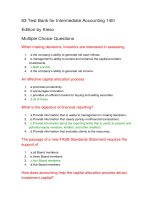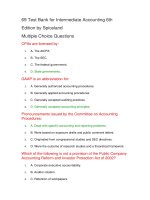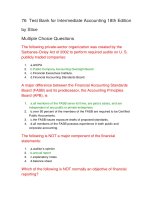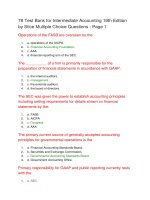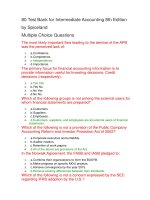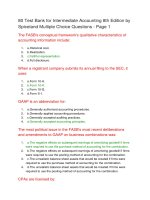40 test bank for intermediate accounting principles and analysis 2nd
Bạn đang xem bản rút gọn của tài liệu. Xem và tải ngay bản đầy đủ của tài liệu tại đây (54.91 KB, 12 trang )
40 Test Bank for Intermediate Accounting Principles
and Analysis 2nd
Edition by Warfield
Multiple Choice Questions
One objective of financial reporting is to provide
1.
a.information about the investors in the business entity.
2.
b.information about the liquidation values of the resources held by the
enterprise.
3.
c.information that is useful in assessing cash flow prospects.
4.
d.information that will attract new investors.
Accounting principles are "generally accepted" only when
1.
a.an authoritative accounting rule-making body has established it in an
official pro-nouncement.
2.
b.it has been accepted as appropriate because of its universal application.
3.
c.both a and b.
4.
d.neither a nor b.
Accrual accounting is used because
1.
a.cash flows are considered less important.
2.
b.it provides a better indication of ability to generate cash flows than the
cash basis.
3.
c.it recognizes revenues when cash is received and expenses when cash is
paid.
4.
d. none of the above.
An organization that has not published accounting standards is
the
1.
a.American Institute of Certified Public Accountants.
2.
b.Securities and Exchange Commission.
3.
c.Financial Accounting Standards Board.
4.
d.All of these have published accounting standards.
The process of identifying, measuring, analyzing, and
communicating financial information needed by management to
plan, evaluate, and control an organization’s operations is called
1.
a.financial accounting.
2.
b.managerial accounting.
3.
c.tax accounting.
4.
d.auditing.
Financial accounting standard-setting in the United States
1.
a.can be described as a social process which reflects political actions of
various interested user groups as well as a product of research and logic.
2.
b.is based solely on research and empirical findings.
3.
c.is a legalistic process based on rules promulgated by governmental
agencies.
4.
d.is democratic in the sense that a majority of accountants must agree with
a standard before it becomes enforceable.
A common set of accounting standards and procedures are
called
1.
a.financial accounting standards.
2.
b.generally accepted accounting principles.
3.
c.objectives of financial reporting.
4.
d.statements of financial accounting concepts.
FASB Technical Bulletins
1.
a.are similar to FASB Interpretations in that they establish enforceable
standards under the AICPA's Code of Professional Ethics.
2.
b.are issued monthly by the FASB to deal with current topics.
3.
c.are not expected to have a significant impact on financial reporting in
general and provide guidance when it does not conflict with any broad
fundamental accounting principle.
4.
d.were recently discontinued by the FASB because they dealt with
specialized topics having little impact on financial reporting in general.
The information provided by financial reporting pertains to
1.
a.individual business enterprises, rather than to industries or an economy
as a whole or to members of society as consumers.
2.
b.business industries, rather than to individual enterprises or an economy
as a whole or to members of society as consumers.
3.
c.individual business enterprises, industries, and an economy as a whole,
rather than to members of society as consumers.
4.
d.an economy as a whole and to members of society as consumers, rather
than to individual enterprises or industries.
The most significant current source of generally accepted
accounting principles is the
1.
a.AICPA.
2.
b.SEC.
3.
c.APB.
4.
d.FASB.
Which of the following is not a part of generally accepted
accounting principles?
1.
a.FASB Interpretations
2.
b.CAP Accounting Research Bulletins
3.
c.APB Opinions
4.
d.All of these are part of generally accepted accounting principles.
General-purpose financial statements are the product of
1.
a.financial accounting.
2.
b.managerial accounting.
3.
c.both financial and managerial accounting.
4.
d.neither financial nor managerial accounting.
The following published documents are part of the "due process"
system used by the FASB in the evolution of a typical FASB
Statement of Financial Accounting Standards: 1.Exposure Draft;
2.Statement of Financial Accounting Standards; 3.Discussion
Memorandum; The chronological order in which these items are
released is as follows:
1.
a.1, 2, 3.
2.
b.1, 3, 2.
3.
c.2, 3, 1.
4.
d.3, 1, 2.
The Financial Accounting Standards Board (FASB) was proposed
by the
1.
a.American Institute of Certified Public Accountants.
2.
b.Accounting Principles Board.
3.
c.Study Group on the Objectives of Financial Statements.
4.
d.Special Study Group on establishment of Accounting Principles (Wheat
Committee).
The most authoritative category of generally accepted accounting
principles includes all of the following except
1.
a.Accounting Research Bulletins.
2.
b.APB Opinions.
3.
c.FASB Standards.
4.
d.FASB Technical Bulletins.
The purpose of Statements of Financial Accounting Concepts is
to
1.
a.establish GAAP.
2.
b.modify or extend the existing FASB Standards Statement.
3.
c.form a conceptual framework for solving existing and emerging problems.
4.
d.determine the need for FASB involvement in an emerging issue.
Which of the following organizations has not been instrumental in
the development of financial accounting standards in the United
States?
1.
a.AICPA
2.
b.FASB
3.
c.IASB
4.
d.SEC
Financial statements in the early 2000s provide information
related to
1.
a.non-financial measurements.
2.
b.forward-looking data.
3.
c.hard assets (inventory and plant assets).
4.
d.none of these.
The role of the Securities and Exchange Commission in the
formulation of accounting principles can be best described as
1.
a.consistently primary.
2.
b.consistently secondary.
3.
c.sometimes primary and sometimes secondary.
4.
d.non-existent.
Generally Accepted Accounting Principles include: 1) FASB
Technical Bulletins, 2) APB Opinions, and 3) Widely-accepted
industry practices. These three items rank from most authoritative
to least authoritative as follows:
1.
a.1, 2, 3.
2.
b.1, 3, 2.
3.
c.2, 1, 3.
4.
d.2, 3, 1.
Which of the following statements is not an objective of financial
reporting?
1.
a.Provide information that is useful in investment and credit decisions.
2.
b.Provide information about enterprise resources, claims to those
resources, and changes to them.
3.
c.Provide information on the liquidation value of an enterprise.
4.
d.Provide information that is useful in assessing cash flow prospects.
An effective capital allocation process
1.
a.promotes productivity.
2.
b.encourages innovation.
3.
c.provides an efficient market for buying and selling securities.
4.
d.all of these.
Members of the Financial Accounting Standards Board are
1.
a.employed by the American Institute of Certified Public Accountants
(AICPA).
2.
b.part-time employees.
3.
c.required to hold a CPA certificate.
4.
d.independent of any other organization.
Generally accepted accounting principles
1.
a.include detailed practices and procedures as well as broad guidelines of
general application.
2.
b.are influenced by pronouncements of the SEC and IRS.
3.
c.change over time as the nature of the business environment changes.
4.
d.all of these.
The Financial Accounting Standards Board
1.
a.has issued a series of pronouncements entitled Statements on Auditing
Standards.
2.
b.was the forerunner of the current Accounting Principles Board.
3.
c.is the arm of the Securities and Exchange Commission responsible for
setting financial accounting standards.
4.
d.is appointed by the Financial Accounting Foundation.
The financial statements most frequently provided include all of
the following except the
1.
a.balance sheet.
2.
b.income statement.
3.
c.statement of cash flows.
4.
d.statement of retained earnings.
The body that has the power to prescribe the accounting
practices and standards to be employed by companies that fall
under its jurisdiction is the
1.
a.FASB.
2.
b.AICPA.
3.
c.SEC.
4.
d.APB.
Companies that are listed on a stock exchange are required to
submit their financial statements to the
1.
a.AICPA.
2.
b.APB
3.
c.FASB.
4.
d.SEC.
Which of the following is not a publication of the FASB?
1.
a.Statements of Financial Accounting Concepts
2.
b.Accounting Research Bulletins
3.
c.Interpretations
4.
d.Technical Bulletins
The purpose of the International Accounting Standards Board is
to
1.
a.issue enforceable standards which regulate the financial accounting and
reporting of multinational corporations.
2.
b.develop a uniform currency in which the financial transactions of
companies through-out the world would be measured.
3.
c.promote uniform accounting standards among countries of the world.
4.
d.arbitrate accounting disputes between auditors and international
companies.
The Governmental Accounting Standards Board
1.
a.oversees the activities of the SEC.
2.
b.is a private-sector body, which addresses state and local governmental
reporting issues.
3.
c.is a division of the Securities and Exchange Commission, which oversees
the corpo-rate accounting in annual reports.
4.
d.was terminated when the Financial Accounting Standards Board was
created.
The major distinction between the Financial Accounting
Standards Board (FASB) and its predecessor, the Accounting
Principles Board (APB), is
1.
a.the FASB issues exposure drafts of proposed standards.
2.
b.all members of the FASB are fully remunerated, serve full time, and are
independent of any companies or institutions.
3.
c.all members of the FASB possess extensive experience in financial
reporting.
4.
d.a majority of the members of the FASB are CPAs drawn from public
practice.
The purpose of the Emerging Issues Task Force is to
1.
a.develop a conceptual framework as a frame of reference for the solution
of future problems.
2.
b.lobby the FASB on issues that affect a particular industry.
3.
c.do research on issues that relate to long-term accounting problems.
4.
d.issue statements which reflect a consensus on how to account for new
and unusual financial transactions that need to be resolved quickly.
In the House of GAAP, is the following on the highest level of
authoritative status (meaning among the most authoritative)?
FASB StatementFASB Statement; FASBof Financialof Financial;
TechnicalAccountingFASBAccounting;
BulletinStandardsInterpretationConcepts
1.
a.YesYesYesYes
2.
b.YesYesYesNo
3.
c.NoYesNoNo
4.
d.NoYesYesNo
Users of financial reports include all of the following except
1.
a.creditors.
2.
b.government agencies.
3.
c.unions.
4.
d.All of these are users.
The Financial Accounting Foundation
1.
a.oversees the operations of the FASB.
2.
b.oversees the operations of the AICPA.
3.
c.provides information to interested parties on financial reporting issues.
4.
d.works with the Financial Accounting Standards Advisory Council to
provide informa-tion to interested parties on financial reporting issues.
The Governmental Accounting Standards Board's main purpose
is to develop standards for
1.
a.the General Accounting Office.
2.
b.the Federal government.
3.
c.state and local government.
4.
d.the Internal Revenue Service.
Which of the following publications does not qualify as a
statement of generally accepted accounting principles?
1.
a.Statements of financial standards issued by the FASB
2.
b.Accounting interpretations issued by the FASB
3.
c.APB Opinions
4.
d.Accounting research studies issued by the AICPA
Whether a business is successful and thrives is determined by
1.
a.markets.
2.
b.free enterprise.
3.
c.competition.
4.
d.all of these.
The Financial Accounting Standards Board employs a "due
process" system which
1.
a.is an efficient system for collecting dues from members.
2.
b.enables interested parties to express their views on issues under
consideration.
3.
c.identifies the accounting issues that are the most important.
4.
d.requires that all accountants must receive a copy of financial standards.


